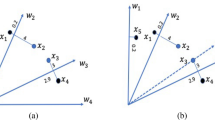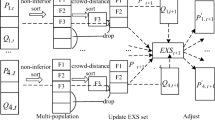Abstract
There are several studies on hybrid multi-operator recombination methods, while few works have been proposed in the area of combining different fitness assignment in a framework. On the other hand, it is known that fitness assignment has a marked impact on the performance of evolutionary multiobjective optimization algorithm (EMOA). In this paper, a hybrid EMOA is proposed, which divides the population into several smaller subpopulations according to their distribution in the objective space. Each subpopulation is evolved by an individual EMOA, and a hybrid performance measure estimates the performance of these EMOAs. We focus on the fitness assignment and assume that all EMOAs used in the subpopulations adopt the same recombination operator. To evaluate performance of the proposed algorithm, we compare it with MOEA/D-M2M, MOE-A/D, SMS-EMOA and NSGA-II on 16 test instances. Experimental results show that the proposed algorithm performs better than or similar to those compared EMOAs.







Similar content being viewed by others
References
Bader J, Zitzler E (2011) HypE: an algorithm for fast hypervolume-based many-objective optimization. Evol Comput 19(1):45–76
Beume N, Fonseca CM, López-Ibáñez M, Paquete L, Vahrenhold J (2009) On the complexity of computing the hypervolume indicator. IEEE Trans Evol Comput 13(5):1075–1082
Branke J, Schmeck H, Deb K, ReddyS M (2004) Parallelizing multiobjective evolutionary algorithms: Cone separation. In: Proceedings of the Congress on Evolutionary Computation, pp 1952–1957
Bringmann K, Friedrich T (2010) An efficient algorithm for computing hypervolume contributions. Evol Comput 18(3):383–402
Burke EK, Gendreau M, Hyde M, Kendall G, Ochoa G, EnderÖzcan QuR (2013) Hyper-heuristics: a survey of the state of the art. J Oper Res Soc 64(12):1695–1724
Chen X, Ong YS, Lim MH, Tan KC (2011) A multi-facet survey on memetic computation. IEEE Trans Evol Comput 15(5):591–607
Deb K (2001) Multiobjective optimization using evolutionary algorithms. Wiley, New York
Deb K, Pratap A, Agarwal S, Meyarivan T (2002) A fast and elitist multiobjective genetic algorithm: NSGA-II. IEEE Trans Evol Comput 6(2):182–197
Deb K, Zope P, Jain A (2003) Distributed computing of pareto-optimal solutions with evolutionary algorithms. In: Proceedings of Evolutionary multi-criterion optimization, pp 534–549
Eckart Z, Marco L, Lothar T (2001) SPEA2: Improving the strength pareto evolutionary algorithm for multiobjective optimization. In: Evolutionary Methods for Design Optimization and Control with Applications to Industrial Problems, pp 95–100
Emmerich M, Beume N, Naujoks B (2005) An EMO algorithm using the hypervolume measure as selection criterion. In: Proceedings of Evolutionary Multi-Criterion Optimization, pp 62–76
Giagkiozis I, Purshouse RC, Fleming PJ (2013) Generalized decomposition. In: Proceedings of Evolutionary multi-criterion optimization, pp 428–442
Gu F, Liu HL, Tan KC (2012) A multiobjective evolutionary algorithm using dynamic weight design method. Int J Innov Comput Inf Control 8(5B):3677–3688
Hadka D, Reed P (2013) Borg: an auto-adaptive many-objective evolutionary computing framework. Evol Comput 21(2):231–259
Hiroyasu T, Miki M, Watanabe S (1999) Distributed genetic algorithms with a new sharing approach in multiobjective optimization problems. In: Proceedings of the Congress on Evolutionary computation, pp 69–76
Hiroyasu T, Miki M, Watanabe S (2000) The new model of parallel genetic algorithm in multiobjective optimization problems divided range multiobjective genetic algorithm. In: Proceedings of the Congress on Evolutionary computation, pp 333–340
Hisao I, Tadashi Y, Tadahiko M (2003) Balance between genetic search and local search in memetic algorithms for multiobjective permutation flowshop scheduling. IEEE Trans Evol Comput 7(2):204–223
Iacca G, Neri F, Mininno E, Ong YS, Lim MH (2012) Ockham’s Razor in memetic computing: three stage optimal memetic exploration. Inf Sci 188:17–43
Kong X, Ouyang H, Piao X (2013) A prediction-based adaptive grouping differential evolution algorithm for constrained numerical optimization. Soft Comput 17(12):2293–2309
Li H, Zhang Q (2009) Multiobjective optimization problems with complicated pareto sets, MOEA/D and NSGA-II. IEEE Trans Evol Comput 13(2):284–302
Liu HL, Wang Y, Cheung YM (2009) A multiobjective evolutionary algorithm using min-max strategy and sphere coordinate transformation. Intell Autom Soft Co 15(3):361–384
Liu HL, Gu F, Cheung YM, Xie S, Zhang J (2014a) On solving WCDMA network planning using iterative power control scheme and evolutionary multiobjective algorithm. IEEE Comput Intell M 9(1):44–52
Liu HL, Gu F, Zhang Q (2014b) Decomposition of a multiobjective optimization problem into a number of simple multiobjective subproblems. IEEE Trans Evol Comput 18(3):450–455
Lu H, Yen GG (2003) Rank-density-based multiobjective genetic algorithm and benchmark test function study. IEEE Trans Evol Comput 7(4):325–343
Miettinen K (1999) Nonlinear multiobjective optimization. Kluwer, Norwell
Nguyen S, Zhang M, Mark J, Tan KC (2013) A computational study of representations in genetic programming to evolve dispatching rules for the job shop scheduling problem. IEEE Trans Evol Comput 17(5):621–639
Nguyen S, Zhang M, Mark J, Tan KC (2014) Automatic design of scheduling policies for dynamic multi-objective job shop scheduling via cooperative coevolution genetic programming. IEEE Trans Evol Comput 18(2):193–208
Nicola B, Naujoks B, Emmerich M (2007) SMS-EMOA: multiobjective selection based on dominated hypervolume. Eur J Oper Res 181(3):1653–1669
Sato H, Aguirre HE, Tanaka K (2004) Local dominance using polar coordinates to enhance multiobjective evolutionary algorithms. In: Proceedings of the Congress on Evolutionary computation, pp 188–195
Sindhya K, Ruuska S, Haanpää T, Miettinen K (2011) A new hybrid mutation operator for multiobjective optimization with differential evolution. Soft Comput 15(10):2041–2055
VanVeldhuizen D, Zydallis J, Lamont G (2003) Considerations in engineering parallel multiobjective evolutionary algorithms. IEEE Trans Evol Comput 7(2):144–173
Vrugt JA, Robinson BA (2007) Improved evolutionary optimization from genetically adaptive multimethod search. Proceedings of the National Academy of Sciences of the United States of America 104(3):708–711
Wang Y, Cai Z, Zhang Q (2011) Differential evolution with composite trial vector generation strategies and control parameters. IEEE Trans Evol Comput 15(1):55–66
Wolpert DH, Macready WG (1997) No free lunch theorems for optimization. IEEE Trans Evol Comput 1(1):67–82
Zhang Q, Li H (2007) MOEA/D: A multiobjective evolutionary algorithm based on decomposition. IEEE Trans Evol Comput 11(6):712–731
Zhao ZQ (2009) A novel modular neural network for imbalanced classification problems. Pattern Recogn Lett 30(9):783–788
Zitzler E, Thiele L, Laumanns M, Fonseca CM, da Fonseca VG (2003) Performance assessment of multiobjective optimizers: An analysis and review. IEEE Trans Evol Comput 7(2):117–132
Acknowledgments
The authors would like to thank Prof. Q. Zhang for giving many suggestions. This work was supported by the Natural Science Foundation of Guangdong Province (S2011030002886, S2012010008813) and the Programme of Science and Technology of Guangzhou (2014J4100209).
Author information
Authors and Affiliations
Corresponding author
Additional information
Communicated by V. Loia.
Rights and permissions
About this article
Cite this article
Gu, F., Liu, HL. & Tan, K.C. A hybrid evolutionary multiobjective optimization algorithm with adaptive multi-fitness assignment. Soft Comput 19, 3249–3259 (2015). https://doi.org/10.1007/s00500-014-1480-9
Published:
Issue Date:
DOI: https://doi.org/10.1007/s00500-014-1480-9




